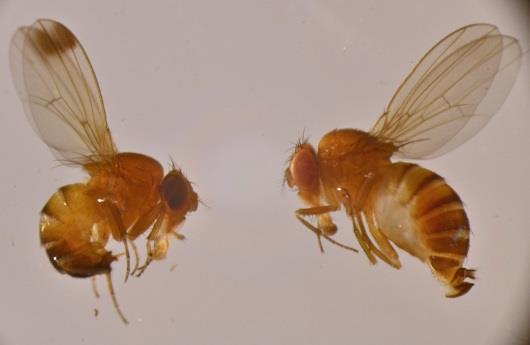Mild Winter and Risk of Spotted Wing Drosophila Infestation
This past winter has been relatively mild, which raises concerns across the country (see recent article in Fruit Growers News) about the potential for early season infestation of fruit crops by spotted wing drosophila (SWD). For caneberry growers, this could translate to earlier and heavier infestation levels. For strawberry and cherry growers, this could be a serious problem, as SWD may be present in high enough numbers at harvest time to cause significant damage to these fruit.

In fact, we received information from Matt Stasiak, superintendent of the Peninsular Ag. Research Station, on June 8th that they caught the first SWD female in Wisconsin for this year in a cherry orchard in Door County. Michigan reported their first SWD in northwest and southwest Michigan on June 3rd. Since its arrival, SWD has not been seen in susceptible fruit crops until the end of June or early July in Wisconsin, which has allowed strawberry to escape SWD infestation.
The growing degree days (GDD) in Door county are exactly the same as in 2015 (~398 GDD) and are very close between years in Dane county (612 GDD in 2016 vs. 660 GDD in 2015). However, we have not caught any SWD in Dane county as of June 8, 2016. This raises a lot of questions that we do not have the answers to right now: why are they showing up in Door county before other parts of the state this year?; why are they detected much earlier (2-3 weeks) than previous years when GDD are not ahead of last year?…
As we try to answer these questions, it is important that strawberry and bramble growers this year think about monitoring for SWD and scout berries for SWD damage and the presence of SWD larvae in berries. Fruit should be sampled for the presence of larvae regularly. To do so, simply cut fruit open and look for larvae, or place suspected fruit in a Ziploc-type bag, slightly crush the fruit and add a salt water solution (1/4 cup salt and 4 cups water). Leave the fruit in the mixture for one hour so that dislodged larvae will float.
If you detect infested fruit, practice sanitation by removing overripe and damaged fruit. Destroy unmarketable fruit by freezing, solarizing inside a clear plastic bag, or burying the fruit at least two feet deep. Do NOT compost infested fruit as it will provide a warm place for SWD to develop! Freezing berries will kill SWD and refrigerating berries (<40F) will stop further development of eggs and larvae inside the fruit, and may kill eggs and larvae after longer refrigeration periods. It is thus recommended to keep berries cool as much as possible, from processor to market to consumer, as this will minimize the chance that larvae will continue to develop inside fruit.
There is no economic threshold for SWD, so if fruit is ripening and SWD flies are trapped in your monitoring traps or larvae are detected in the fruit, you may need to apply some chemical controls. If you decide to spray, apply insecticides in short intervals (5-7 days) to prevent crop infestation, and continue to spray from when the fruit is beginning to ripen until harvest is completed (taking pre-harvest intervals into account). A list of insecticides that have been shown to be effective against SWD in strawberry is provided below.
| Class (IRAC) | Trade name | Active ingredient | REI | PHI (days) | Rate (per acre) | Efficacy for SWD | Comments |
| Carbamates (1A) | Sevin XLR PLus | Carbaryl | 12hrs | 7 | 1-2 quarts | Good | No more than 10 quarts/acre/year Max of 5 application/year 7-day interval between applications Caution: may injure Early Dawn and Sunrise varieties |
| Organo-phosphates (1B) | Malathion | Malathion | 12hrs | 3 | 1.5 – 3.2 pints | Excellent | No more than 2 lbs. a.i./year No more than 4 applications per year 7 day interval between applications |
| Pyrethroids and Pyrethrins (3A) | Brigade WSB | Bifenthrin | 12hrs | None | 6.4 – 32 oz. | Good | Max of 80 oz./acre/year 7-14 day interval between applications |
| Danitol 2.4EC | Fen-propathrin | 24hrs | 2 | 10 ⅔ – 21 ⅓ fl. oz. | Excellent | Max of 42 ⅔ fl. oz./acre/year Max of 2 applications/year | |
| Pyganic OMRI | Pyrethrum | 12hrs | 12hrs | 16 – 64 oz. | Good | Recommended that final spray mix be buffered to pH of 5.5 – 7.0 day interval between applications | |
| Spinosyns (5) | Entrust OMRI | Spinosad | 4hrs | 1 | 1.25 – 2 oz. | Good | Max of 9 oz./acre/season Max of 5 applications/year or 3 applications/crop 5 day interval between application |
This is not a comprehensive list. Trade names are provided as examples of specific active ingredients. Other products may be registered with the same active ingredient and no endorsement or recommendation of a particular trade name is implied. Research is ongoing and recommendations for SWD are constantly changing as research results become available. Please, make sure to always read and follow label instructions carefully. Human error happens, so please double check rates and other information on the label! Happy growing season!
This article was posted in Insects and tagged Christelle Guédot, insects, Spotted Wing Drosophila, SWD.
